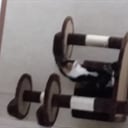Which of the following vegetables grows so fast that it can actually be heard?
If you stand quietly in an almost pitch-black room, surrounded by budding rhubarb, you may be surprised to hear squeak, crackle, pop.
Unlike many other vegetables, being grown in the dark actually speeds up the growth of rhubarb. Forced rhubarb, as it's called, can grow by as much as an inch a day, and that rapid growth causes the stalks to rub together, and produce an audible sound.
The process of raising forced rhubarb isn't new. Farmers came up with the concept in the early 1800s. The rhubarb plant is allowed to grow outdoors for two years. During that time, the roots collect and store calories, while the plants soak up sunlight. In early winter (usually around November in the northern hemisphere), the plants are transplanted very close together in dark, heated growing sheds, where they continue to develop, out of season, without light.
The rhubarb stalks continue to grow, in the dark, at an astonishing rate of about one inch a day. As the stalks burst up out of their initial buds, they create a distinct popping sound, and as they get larger, the stalks rub together to create squeaks and creaks.
There are advantages to the unique growing process. Growing outdoors in sunshine, as rhubarb usually does in home gardens, makes rhubarb stalks tough and fibrous. Being deprived of sunshine & photosynthesis makes for more tender, less stringy, and less tart rhubarb. The “in the dark” process also results in deep, red stalks, without the normal green tinge.
More Info:
www.atlasobscura.com



